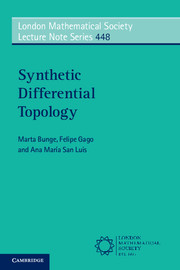Preface
Published online by Cambridge University Press: 16 March 2018
Summary
The subject of synthetic differential geometry has its origins in lectures and papers by F. William Lawvere, most notably [72], but see also [74, 76]. It extends the pioneering work of Charles Ehresmann [40] and André Weil [111] to the setting of a topos [73, 55]. It is synthetic (as opposed to analytic) in that the basic concepts of the differential calculus are introduced by axioms rather than by definition using limits or other quantitative data. It attempts to capture the classical concepts of differential geometry in an intuitive fashion using the rich structure of a topos (finite limits, exponentiation, subobject classifier) in order to conceptually simplify both the statements and their proofs. The fact that the intrinsic logic of any topos model of the theory is necessarily Heyting (or intuitionistic) rather than Boolean (or classical) plays a crucial role in its development. It is well adapted to the study of classical differential geometry by virtue of some of its models.
This book is intended as a natural extension of synthetic differential geometry (SDG), in particular of the book by Anders Kock [61] to (a subject that we here call) synthetic differential topology (SDT). Whereas the basic axioms of SDG are the representability of jets (of smooth mappings) by tiny objects of an algebraic nature, those of SDT are the representability of germs (of smooth mappings) by tiny objects of a logical sort introduced by Jacques Penon [96, 94, 95]. In both cases, additional axioms and postulates are added to the basic ones in order to develop special portions of the theory.
In a first part we include those portions of topos theory and of synthetic differential geometry that should minimally suffice for a reading of the book. As an illustration of the benefits of working synthetically within topos theory we include in a second part a version of the theory of connections and sprays [28, 22] as well as one of the calculus of variations [52, 27]. The basic axioms for SDT were introduced in [20, 25, 26] and are the contents of the third part of this book.
- Type
- Chapter
- Information
- Synthetic Differential Topology , pp. vii - viiiPublisher: Cambridge University PressPrint publication year: 2018



